Financial Management Report: Dividend Relevance, M&A and Growth
VerifiedAdded on 2020/06/05
|13
|4109
|180
Report
AI Summary
This report delves into the core concepts of financial management, focusing on the relevance and irrelevance of dividend policies in relation to share prices. It examines the dividend relevance theories of Walter and Gordon, exploring how dividend payouts can affect firm value and shareholder wealth, as well as the dividend irrelevance theory of Modigliani and Miller. The report also analyzes the fundamental role of mergers and acquisitions (M&A) in corporate finance, highlighting their impact on external growth opportunities and the maximization of shareholder wealth. The report discusses various types of mergers, the strategies behind M&A, and the situations where M&A proves to be an effective growth strategy, including filling critical gaps, acquiring skilled talent, leveraging synergies, introducing new business models, and saving time and resources. Overall, the report provides a comprehensive overview of how financial decisions, including dividend policies and M&A, shape a company's financial performance and strategic growth.
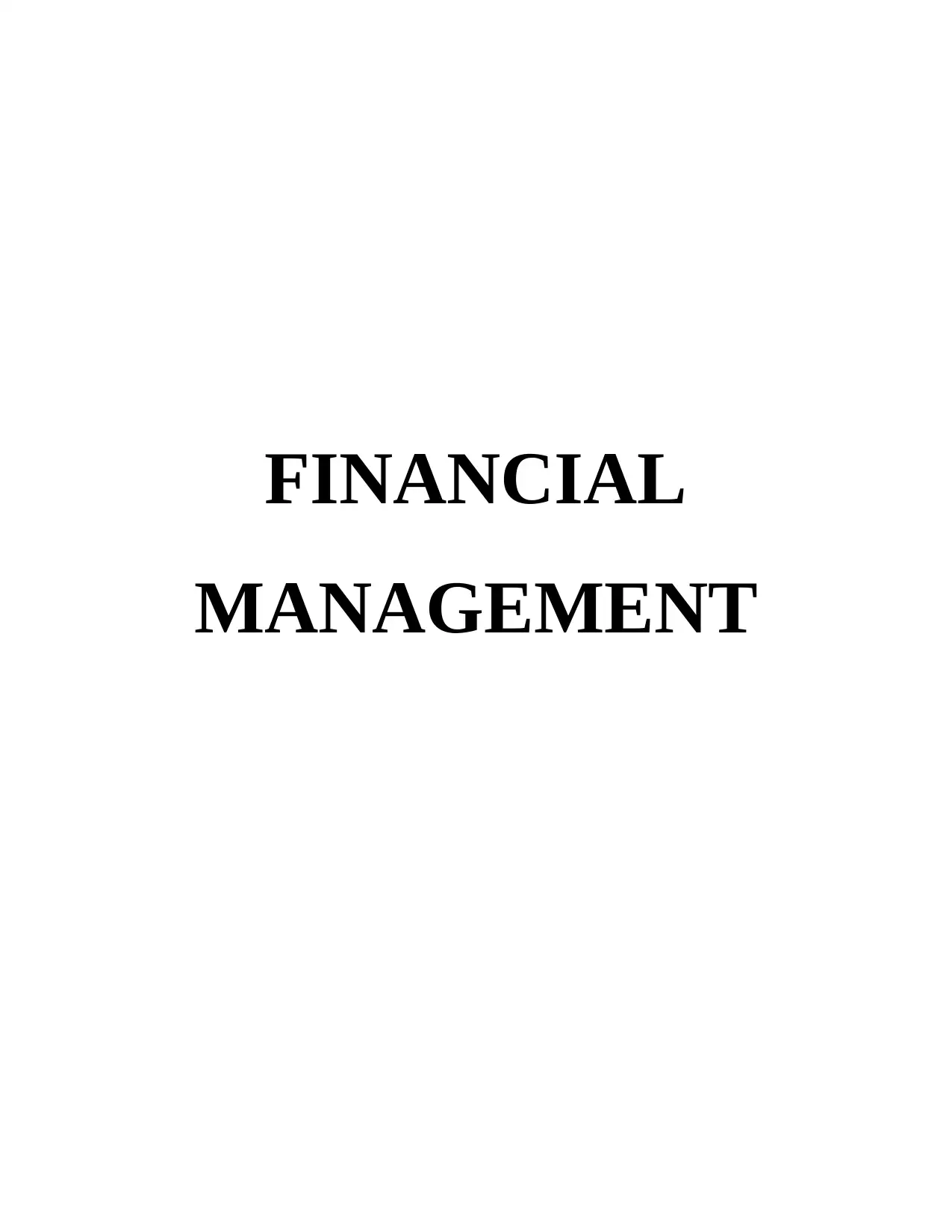
FINANCIAL
MANAGEMENT
MANAGEMENT
Paraphrase This Document
Need a fresh take? Get an instant paraphrase of this document with our AI Paraphraser
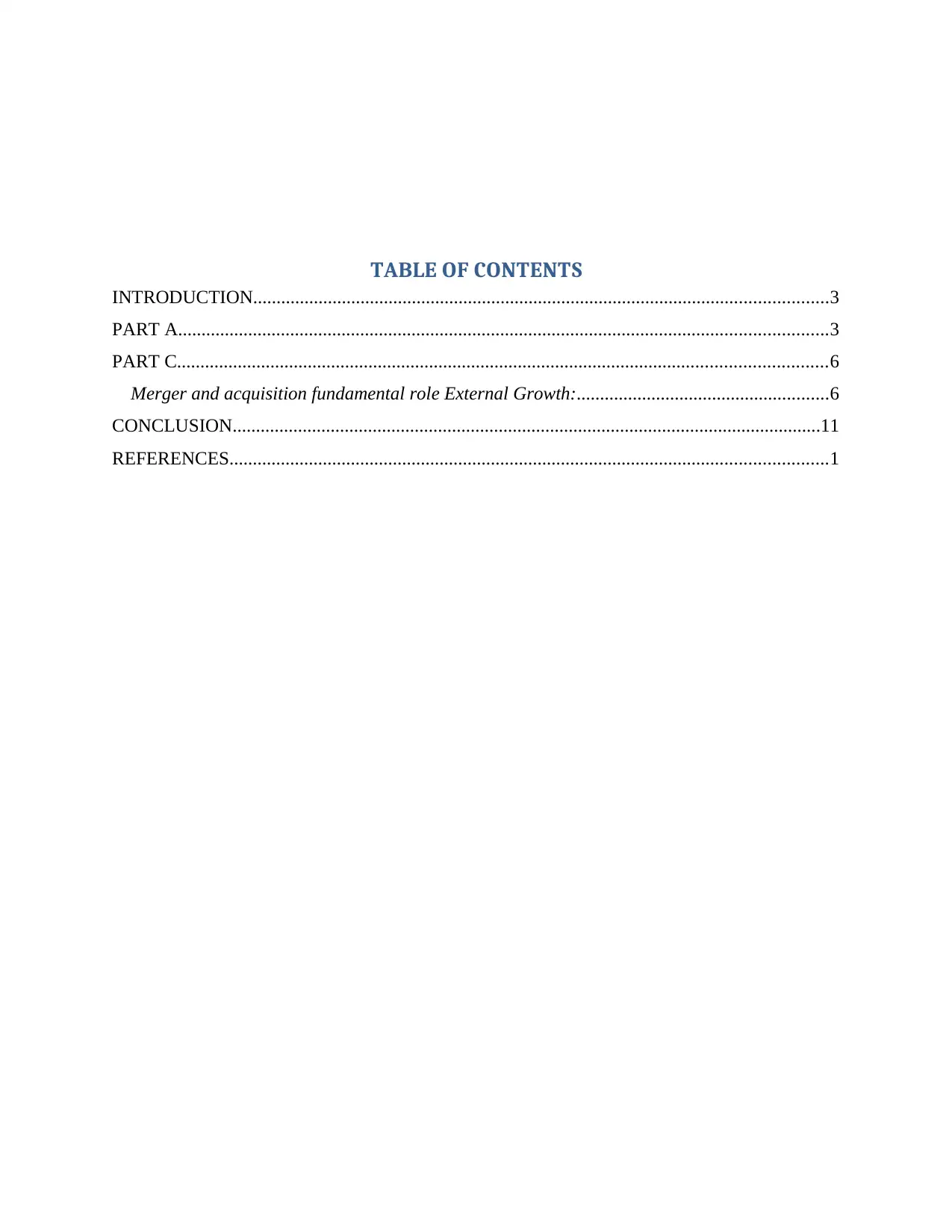
TABLE OF CONTENTS
INTRODUCTION...........................................................................................................................3
PART A...........................................................................................................................................3
PART C...........................................................................................................................................6
Merger and acquisition fundamental role External Growth:......................................................6
CONCLUSION..............................................................................................................................11
REFERENCES................................................................................................................................1
INTRODUCTION...........................................................................................................................3
PART A...........................................................................................................................................3
PART C...........................................................................................................................................6
Merger and acquisition fundamental role External Growth:......................................................6
CONCLUSION..............................................................................................................................11
REFERENCES................................................................................................................................1
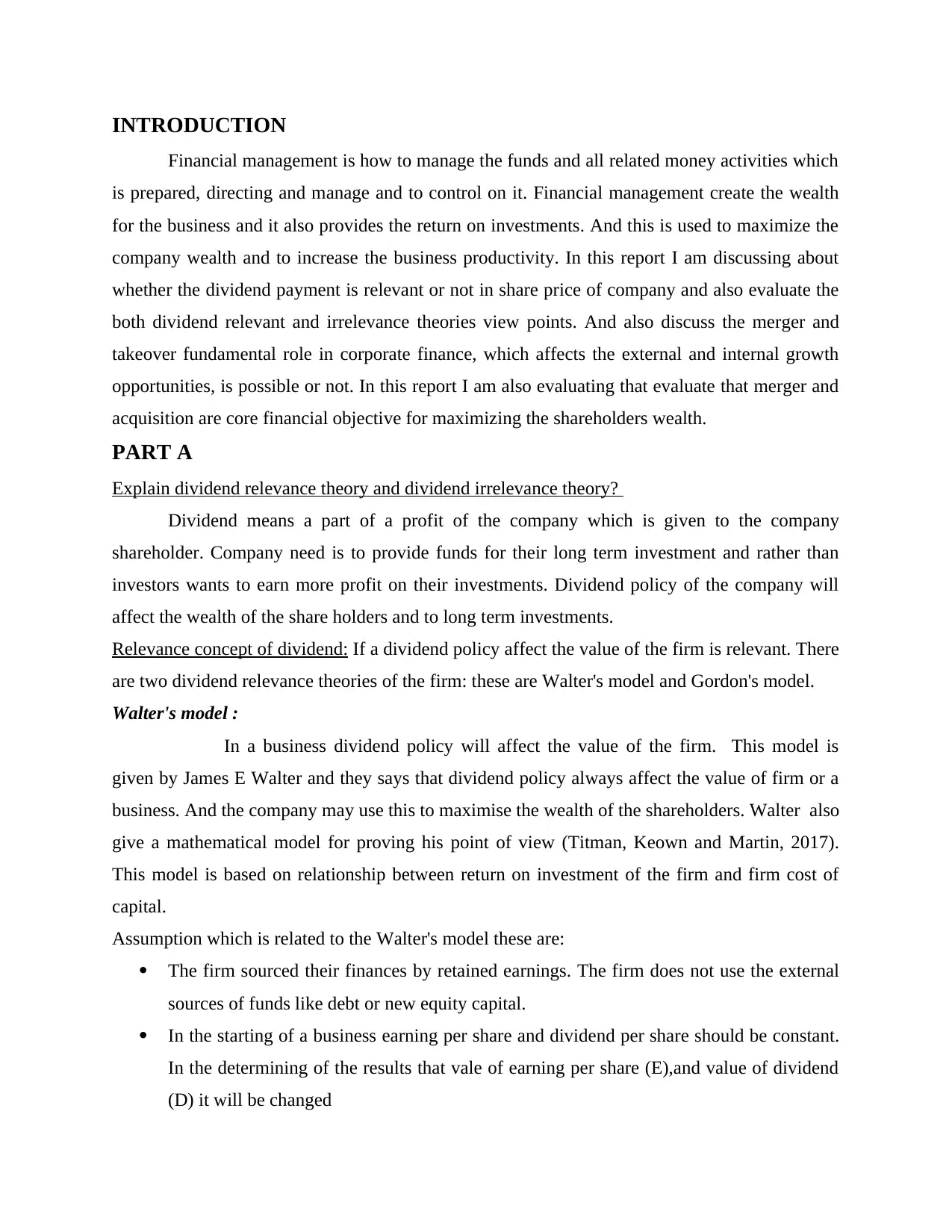
INTRODUCTION
Financial management is how to manage the funds and all related money activities which
is prepared, directing and manage and to control on it. Financial management create the wealth
for the business and it also provides the return on investments. And this is used to maximize the
company wealth and to increase the business productivity. In this report I am discussing about
whether the dividend payment is relevant or not in share price of company and also evaluate the
both dividend relevant and irrelevance theories view points. And also discuss the merger and
takeover fundamental role in corporate finance, which affects the external and internal growth
opportunities, is possible or not. In this report I am also evaluating that evaluate that merger and
acquisition are core financial objective for maximizing the shareholders wealth.
PART A
Explain dividend relevance theory and dividend irrelevance theory?
Dividend means a part of a profit of the company which is given to the company
shareholder. Company need is to provide funds for their long term investment and rather than
investors wants to earn more profit on their investments. Dividend policy of the company will
affect the wealth of the share holders and to long term investments.
Relevance concept of dividend: If a dividend policy affect the value of the firm is relevant. There
are two dividend relevance theories of the firm: these are Walter's model and Gordon's model.
Walter's model :
In a business dividend policy will affect the value of the firm. This model is
given by James E Walter and they says that dividend policy always affect the value of firm or a
business. And the company may use this to maximise the wealth of the shareholders. Walter also
give a mathematical model for proving his point of view (Titman, Keown and Martin, 2017).
This model is based on relationship between return on investment of the firm and firm cost of
capital.
Assumption which is related to the Walter's model these are:
The firm sourced their finances by retained earnings. The firm does not use the external
sources of funds like debt or new equity capital.
In the starting of a business earning per share and dividend per share should be constant.
In the determining of the results that vale of earning per share (E),and value of dividend
(D) it will be changed
Financial management is how to manage the funds and all related money activities which
is prepared, directing and manage and to control on it. Financial management create the wealth
for the business and it also provides the return on investments. And this is used to maximize the
company wealth and to increase the business productivity. In this report I am discussing about
whether the dividend payment is relevant or not in share price of company and also evaluate the
both dividend relevant and irrelevance theories view points. And also discuss the merger and
takeover fundamental role in corporate finance, which affects the external and internal growth
opportunities, is possible or not. In this report I am also evaluating that evaluate that merger and
acquisition are core financial objective for maximizing the shareholders wealth.
PART A
Explain dividend relevance theory and dividend irrelevance theory?
Dividend means a part of a profit of the company which is given to the company
shareholder. Company need is to provide funds for their long term investment and rather than
investors wants to earn more profit on their investments. Dividend policy of the company will
affect the wealth of the share holders and to long term investments.
Relevance concept of dividend: If a dividend policy affect the value of the firm is relevant. There
are two dividend relevance theories of the firm: these are Walter's model and Gordon's model.
Walter's model :
In a business dividend policy will affect the value of the firm. This model is
given by James E Walter and they says that dividend policy always affect the value of firm or a
business. And the company may use this to maximise the wealth of the shareholders. Walter also
give a mathematical model for proving his point of view (Titman, Keown and Martin, 2017).
This model is based on relationship between return on investment of the firm and firm cost of
capital.
Assumption which is related to the Walter's model these are:
The firm sourced their finances by retained earnings. The firm does not use the external
sources of funds like debt or new equity capital.
In the starting of a business earning per share and dividend per share should be constant.
In the determining of the results that vale of earning per share (E),and value of dividend
(D) it will be changed
⊘ This is a preview!⊘
Do you want full access?
Subscribe today to unlock all pages.

Trusted by 1+ million students worldwide
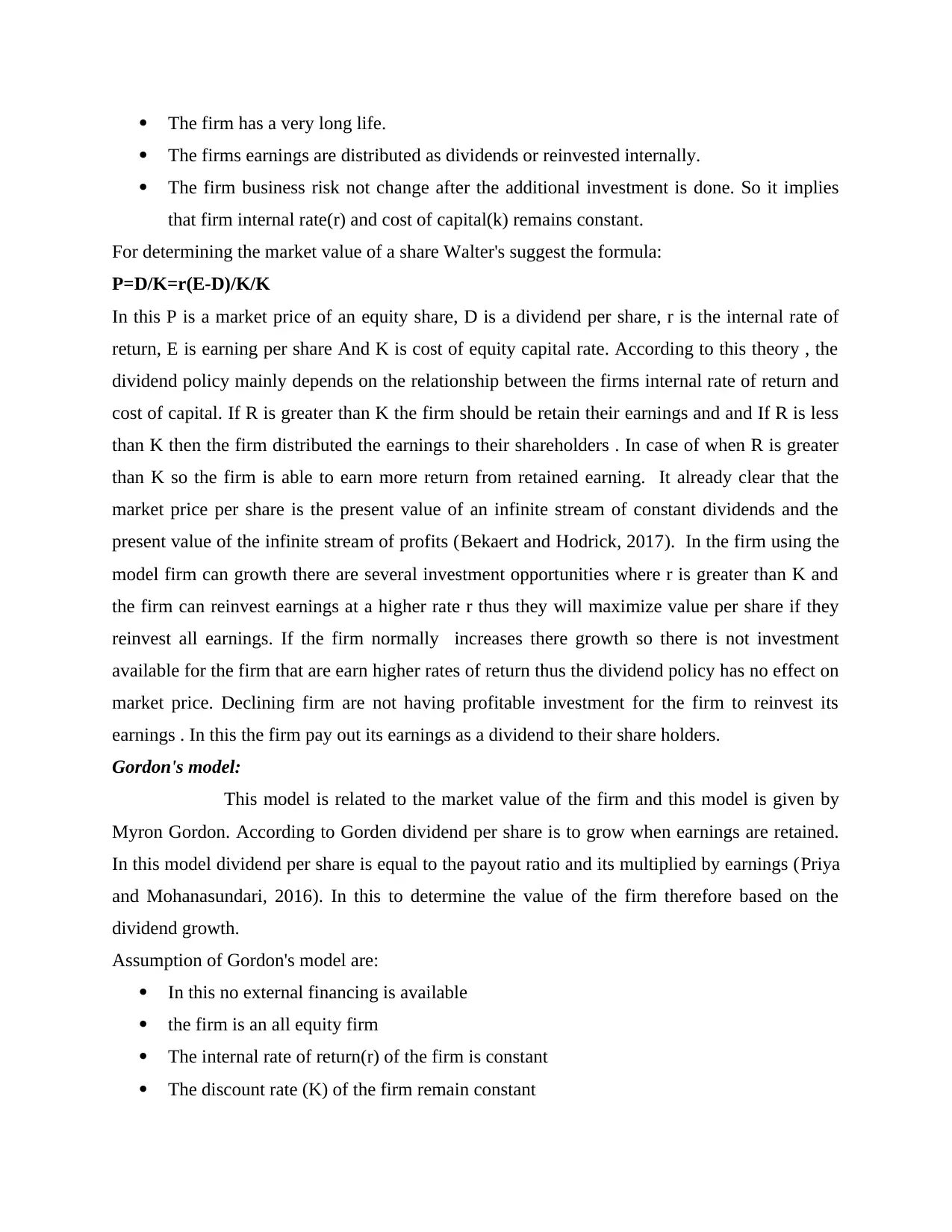
The firm has a very long life.
The firms earnings are distributed as dividends or reinvested internally.
The firm business risk not change after the additional investment is done. So it implies
that firm internal rate(r) and cost of capital(k) remains constant.
For determining the market value of a share Walter's suggest the formula:
P=D/K=r(E-D)/K/K
In this P is a market price of an equity share, D is a dividend per share, r is the internal rate of
return, E is earning per share And K is cost of equity capital rate. According to this theory , the
dividend policy mainly depends on the relationship between the firms internal rate of return and
cost of capital. If R is greater than K the firm should be retain their earnings and and If R is less
than K then the firm distributed the earnings to their shareholders . In case of when R is greater
than K so the firm is able to earn more return from retained earning. It already clear that the
market price per share is the present value of an infinite stream of constant dividends and the
present value of the infinite stream of profits (Bekaert and Hodrick, 2017). In the firm using the
model firm can growth there are several investment opportunities where r is greater than K and
the firm can reinvest earnings at a higher rate r thus they will maximize value per share if they
reinvest all earnings. If the firm normally increases there growth so there is not investment
available for the firm that are earn higher rates of return thus the dividend policy has no effect on
market price. Declining firm are not having profitable investment for the firm to reinvest its
earnings . In this the firm pay out its earnings as a dividend to their share holders.
Gordon's model:
This model is related to the market value of the firm and this model is given by
Myron Gordon. According to Gorden dividend per share is to grow when earnings are retained.
In this model dividend per share is equal to the payout ratio and its multiplied by earnings (Priya
and Mohanasundari, 2016). In this to determine the value of the firm therefore based on the
dividend growth.
Assumption of Gordon's model are:
In this no external financing is available
the firm is an all equity firm
The internal rate of return(r) of the firm is constant
The discount rate (K) of the firm remain constant
The firms earnings are distributed as dividends or reinvested internally.
The firm business risk not change after the additional investment is done. So it implies
that firm internal rate(r) and cost of capital(k) remains constant.
For determining the market value of a share Walter's suggest the formula:
P=D/K=r(E-D)/K/K
In this P is a market price of an equity share, D is a dividend per share, r is the internal rate of
return, E is earning per share And K is cost of equity capital rate. According to this theory , the
dividend policy mainly depends on the relationship between the firms internal rate of return and
cost of capital. If R is greater than K the firm should be retain their earnings and and If R is less
than K then the firm distributed the earnings to their shareholders . In case of when R is greater
than K so the firm is able to earn more return from retained earning. It already clear that the
market price per share is the present value of an infinite stream of constant dividends and the
present value of the infinite stream of profits (Bekaert and Hodrick, 2017). In the firm using the
model firm can growth there are several investment opportunities where r is greater than K and
the firm can reinvest earnings at a higher rate r thus they will maximize value per share if they
reinvest all earnings. If the firm normally increases there growth so there is not investment
available for the firm that are earn higher rates of return thus the dividend policy has no effect on
market price. Declining firm are not having profitable investment for the firm to reinvest its
earnings . In this the firm pay out its earnings as a dividend to their share holders.
Gordon's model:
This model is related to the market value of the firm and this model is given by
Myron Gordon. According to Gorden dividend per share is to grow when earnings are retained.
In this model dividend per share is equal to the payout ratio and its multiplied by earnings (Priya
and Mohanasundari, 2016). In this to determine the value of the firm therefore based on the
dividend growth.
Assumption of Gordon's model are:
In this no external financing is available
the firm is an all equity firm
The internal rate of return(r) of the firm is constant
The discount rate (K) of the firm remain constant
Paraphrase This Document
Need a fresh take? Get an instant paraphrase of this document with our AI Paraphraser
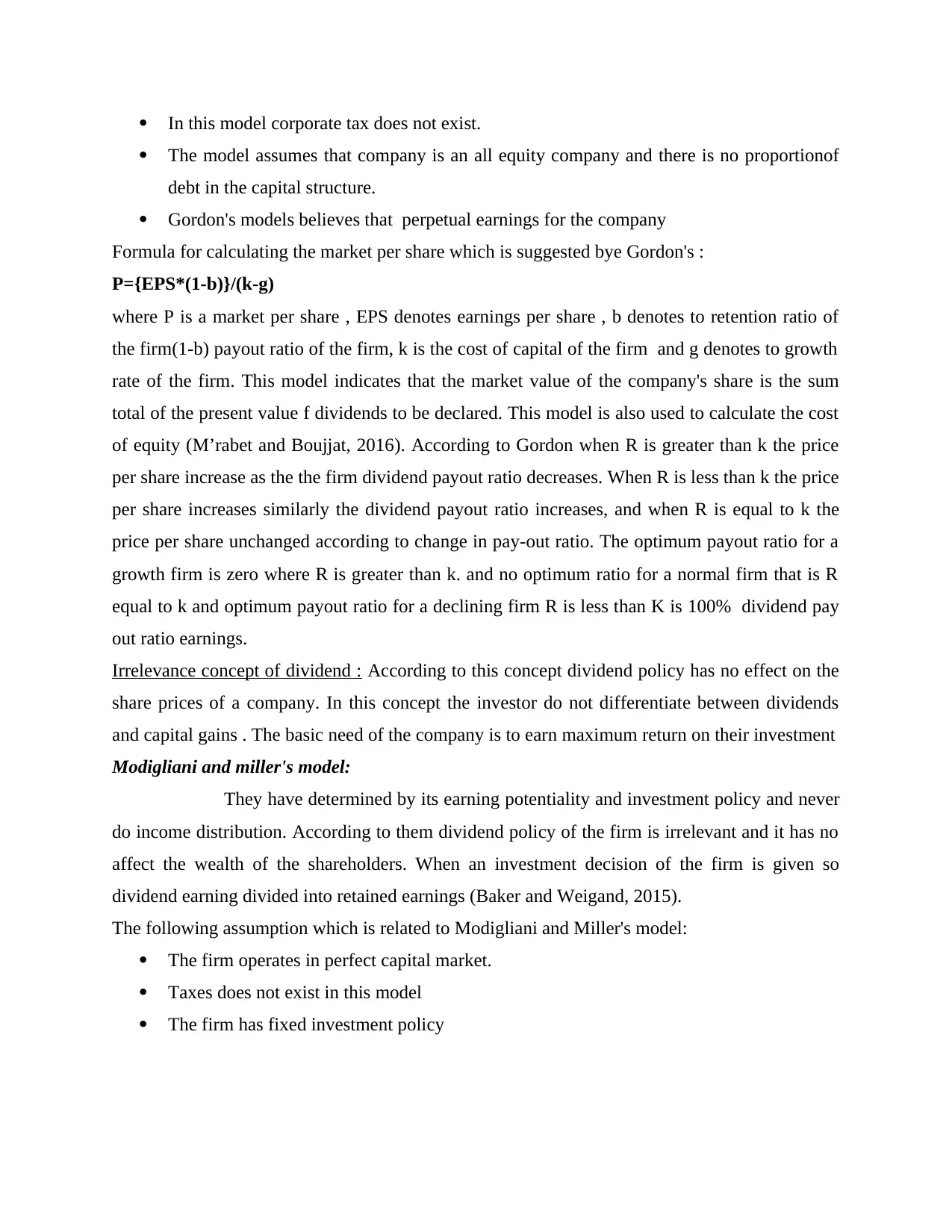
In this model corporate tax does not exist.
The model assumes that company is an all equity company and there is no proportionof
debt in the capital structure.
Gordon's models believes that perpetual earnings for the company
Formula for calculating the market per share which is suggested bye Gordon's :
P={EPS*(1-b)}/(k-g)
where P is a market per share , EPS denotes earnings per share , b denotes to retention ratio of
the firm(1-b) payout ratio of the firm, k is the cost of capital of the firm and g denotes to growth
rate of the firm. This model indicates that the market value of the company's share is the sum
total of the present value f dividends to be declared. This model is also used to calculate the cost
of equity (M’rabet and Boujjat, 2016). According to Gordon when R is greater than k the price
per share increase as the the firm dividend payout ratio decreases. When R is less than k the price
per share increases similarly the dividend payout ratio increases, and when R is equal to k the
price per share unchanged according to change in pay-out ratio. The optimum payout ratio for a
growth firm is zero where R is greater than k. and no optimum ratio for a normal firm that is R
equal to k and optimum payout ratio for a declining firm R is less than K is 100% dividend pay
out ratio earnings.
Irrelevance concept of dividend : According to this concept dividend policy has no effect on the
share prices of a company. In this concept the investor do not differentiate between dividends
and capital gains . The basic need of the company is to earn maximum return on their investment
Modigliani and miller's model:
They have determined by its earning potentiality and investment policy and never
do income distribution. According to them dividend policy of the firm is irrelevant and it has no
affect the wealth of the shareholders. When an investment decision of the firm is given so
dividend earning divided into retained earnings (Baker and Weigand, 2015).
The following assumption which is related to Modigliani and Miller's model:
The firm operates in perfect capital market.
Taxes does not exist in this model
The firm has fixed investment policy
The model assumes that company is an all equity company and there is no proportionof
debt in the capital structure.
Gordon's models believes that perpetual earnings for the company
Formula for calculating the market per share which is suggested bye Gordon's :
P={EPS*(1-b)}/(k-g)
where P is a market per share , EPS denotes earnings per share , b denotes to retention ratio of
the firm(1-b) payout ratio of the firm, k is the cost of capital of the firm and g denotes to growth
rate of the firm. This model indicates that the market value of the company's share is the sum
total of the present value f dividends to be declared. This model is also used to calculate the cost
of equity (M’rabet and Boujjat, 2016). According to Gordon when R is greater than k the price
per share increase as the the firm dividend payout ratio decreases. When R is less than k the price
per share increases similarly the dividend payout ratio increases, and when R is equal to k the
price per share unchanged according to change in pay-out ratio. The optimum payout ratio for a
growth firm is zero where R is greater than k. and no optimum ratio for a normal firm that is R
equal to k and optimum payout ratio for a declining firm R is less than K is 100% dividend pay
out ratio earnings.
Irrelevance concept of dividend : According to this concept dividend policy has no effect on the
share prices of a company. In this concept the investor do not differentiate between dividends
and capital gains . The basic need of the company is to earn maximum return on their investment
Modigliani and miller's model:
They have determined by its earning potentiality and investment policy and never
do income distribution. According to them dividend policy of the firm is irrelevant and it has no
affect the wealth of the shareholders. When an investment decision of the firm is given so
dividend earning divided into retained earnings (Baker and Weigand, 2015).
The following assumption which is related to Modigliani and Miller's model:
The firm operates in perfect capital market.
Taxes does not exist in this model
The firm has fixed investment policy
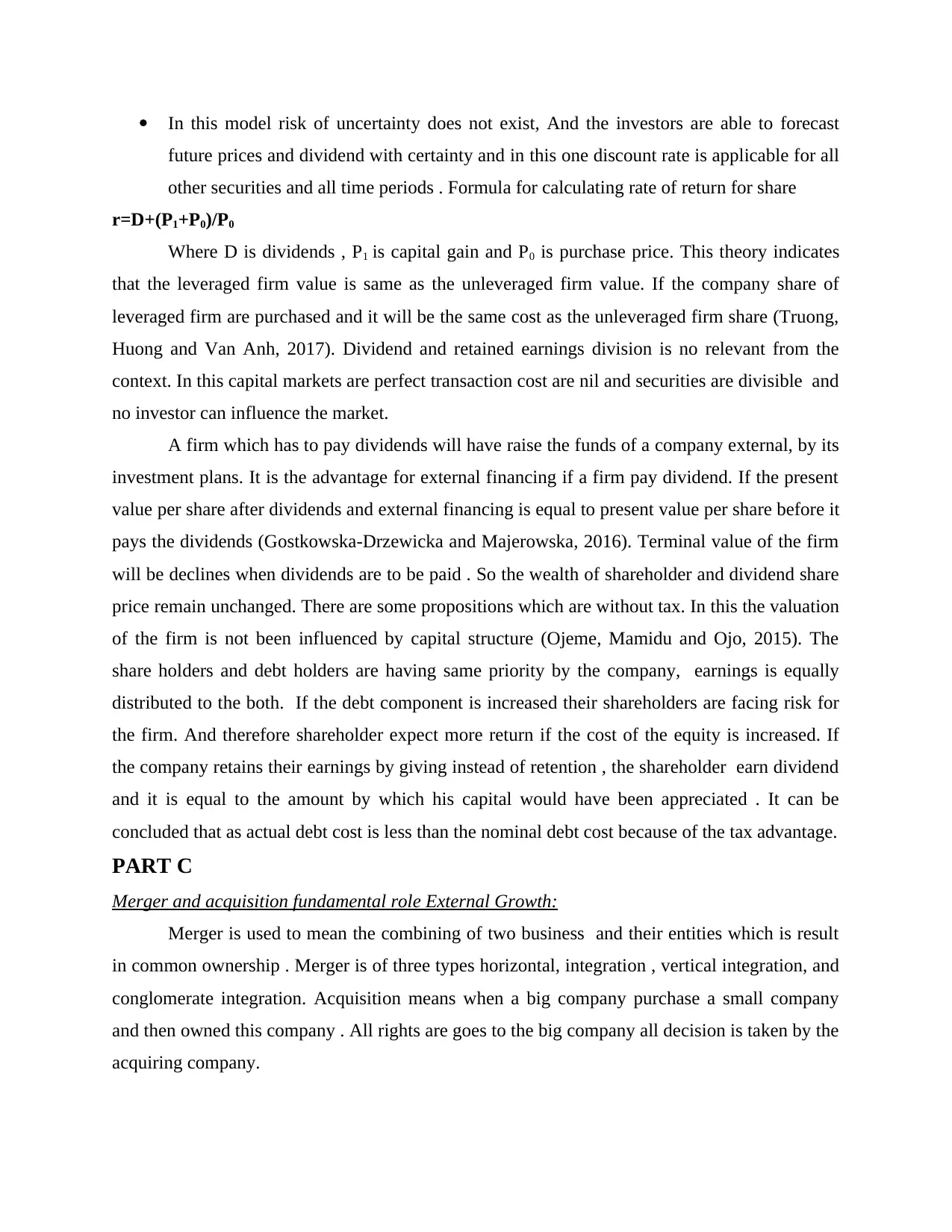
In this model risk of uncertainty does not exist, And the investors are able to forecast
future prices and dividend with certainty and in this one discount rate is applicable for all
other securities and all time periods . Formula for calculating rate of return for share
r=D+(P1+P0)/P0
Where D is dividends , P1 is capital gain and P0 is purchase price. This theory indicates
that the leveraged firm value is same as the unleveraged firm value. If the company share of
leveraged firm are purchased and it will be the same cost as the unleveraged firm share (Truong,
Huong and Van Anh, 2017). Dividend and retained earnings division is no relevant from the
context. In this capital markets are perfect transaction cost are nil and securities are divisible and
no investor can influence the market.
A firm which has to pay dividends will have raise the funds of a company external, by its
investment plans. It is the advantage for external financing if a firm pay dividend. If the present
value per share after dividends and external financing is equal to present value per share before it
pays the dividends (Gostkowska-Drzewicka and Majerowska, 2016). Terminal value of the firm
will be declines when dividends are to be paid . So the wealth of shareholder and dividend share
price remain unchanged. There are some propositions which are without tax. In this the valuation
of the firm is not been influenced by capital structure (Ojeme, Mamidu and Ojo, 2015). The
share holders and debt holders are having same priority by the company, earnings is equally
distributed to the both. If the debt component is increased their shareholders are facing risk for
the firm. And therefore shareholder expect more return if the cost of the equity is increased. If
the company retains their earnings by giving instead of retention , the shareholder earn dividend
and it is equal to the amount by which his capital would have been appreciated . It can be
concluded that as actual debt cost is less than the nominal debt cost because of the tax advantage.
PART C
Merger and acquisition fundamental role External Growth:
Merger is used to mean the combining of two business and their entities which is result
in common ownership . Merger is of three types horizontal, integration , vertical integration, and
conglomerate integration. Acquisition means when a big company purchase a small company
and then owned this company . All rights are goes to the big company all decision is taken by the
acquiring company.
future prices and dividend with certainty and in this one discount rate is applicable for all
other securities and all time periods . Formula for calculating rate of return for share
r=D+(P1+P0)/P0
Where D is dividends , P1 is capital gain and P0 is purchase price. This theory indicates
that the leveraged firm value is same as the unleveraged firm value. If the company share of
leveraged firm are purchased and it will be the same cost as the unleveraged firm share (Truong,
Huong and Van Anh, 2017). Dividend and retained earnings division is no relevant from the
context. In this capital markets are perfect transaction cost are nil and securities are divisible and
no investor can influence the market.
A firm which has to pay dividends will have raise the funds of a company external, by its
investment plans. It is the advantage for external financing if a firm pay dividend. If the present
value per share after dividends and external financing is equal to present value per share before it
pays the dividends (Gostkowska-Drzewicka and Majerowska, 2016). Terminal value of the firm
will be declines when dividends are to be paid . So the wealth of shareholder and dividend share
price remain unchanged. There are some propositions which are without tax. In this the valuation
of the firm is not been influenced by capital structure (Ojeme, Mamidu and Ojo, 2015). The
share holders and debt holders are having same priority by the company, earnings is equally
distributed to the both. If the debt component is increased their shareholders are facing risk for
the firm. And therefore shareholder expect more return if the cost of the equity is increased. If
the company retains their earnings by giving instead of retention , the shareholder earn dividend
and it is equal to the amount by which his capital would have been appreciated . It can be
concluded that as actual debt cost is less than the nominal debt cost because of the tax advantage.
PART C
Merger and acquisition fundamental role External Growth:
Merger is used to mean the combining of two business and their entities which is result
in common ownership . Merger is of three types horizontal, integration , vertical integration, and
conglomerate integration. Acquisition means when a big company purchase a small company
and then owned this company . All rights are goes to the big company all decision is taken by the
acquiring company.
⊘ This is a preview!⊘
Do you want full access?
Subscribe today to unlock all pages.

Trusted by 1+ million students worldwide
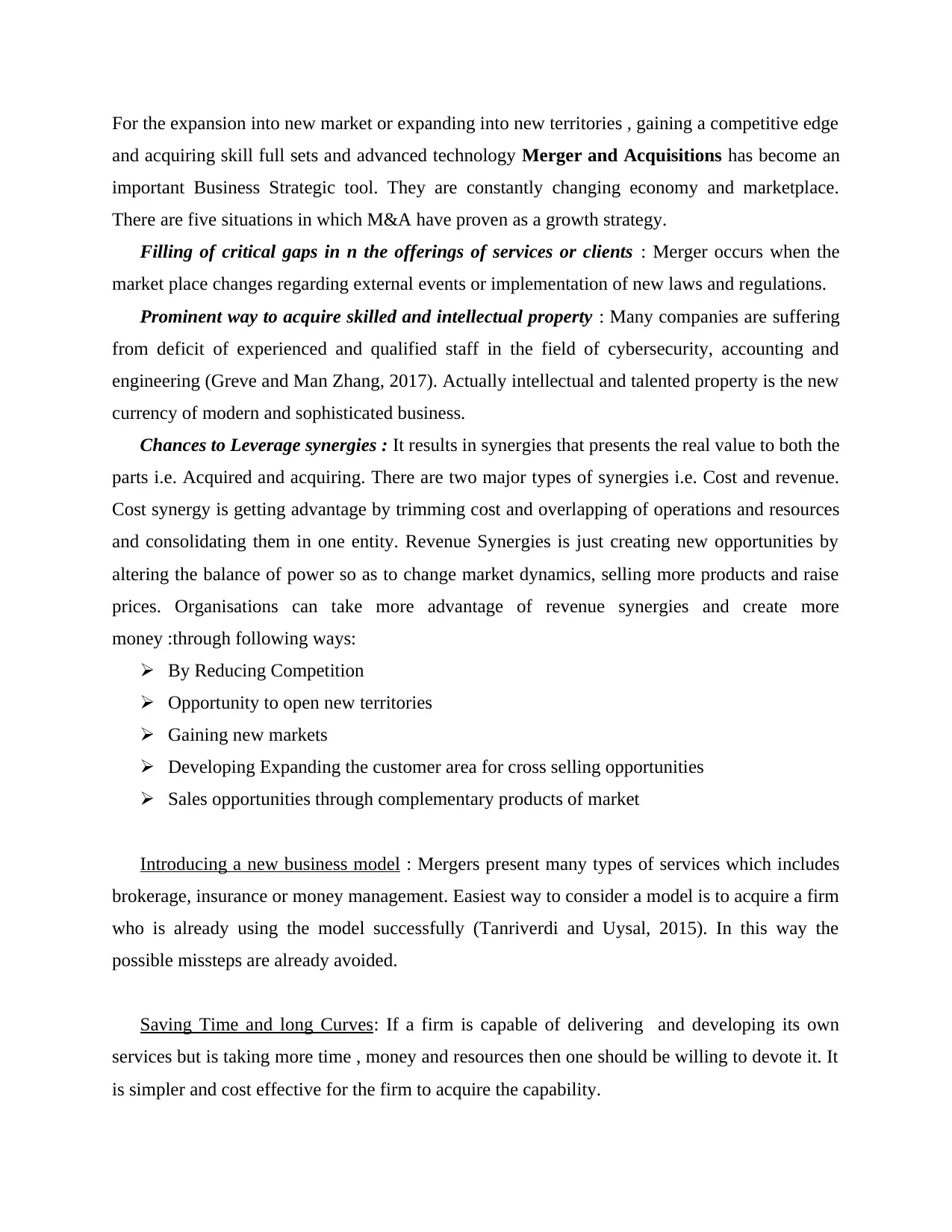
For the expansion into new market or expanding into new territories , gaining a competitive edge
and acquiring skill full sets and advanced technology Merger and Acquisitions has become an
important Business Strategic tool. They are constantly changing economy and marketplace.
There are five situations in which M&A have proven as a growth strategy.
Filling of critical gaps in n the offerings of services or clients : Merger occurs when the
market place changes regarding external events or implementation of new laws and regulations.
Prominent way to acquire skilled and intellectual property : Many companies are suffering
from deficit of experienced and qualified staff in the field of cybersecurity, accounting and
engineering (Greve and Man Zhang, 2017). Actually intellectual and talented property is the new
currency of modern and sophisticated business.
Chances to Leverage synergies : It results in synergies that presents the real value to both the
parts i.e. Acquired and acquiring. There are two major types of synergies i.e. Cost and revenue.
Cost synergy is getting advantage by trimming cost and overlapping of operations and resources
and consolidating them in one entity. Revenue Synergies is just creating new opportunities by
altering the balance of power so as to change market dynamics, selling more products and raise
prices. Organisations can take more advantage of revenue synergies and create more
money :through following ways:
By Reducing Competition
Opportunity to open new territories
Gaining new markets
Developing Expanding the customer area for cross selling opportunities
Sales opportunities through complementary products of market
Introducing a new business model : Mergers present many types of services which includes
brokerage, insurance or money management. Easiest way to consider a model is to acquire a firm
who is already using the model successfully (Tanriverdi and Uysal, 2015). In this way the
possible missteps are already avoided.
Saving Time and long Curves: If a firm is capable of delivering and developing its own
services but is taking more time , money and resources then one should be willing to devote it. It
is simpler and cost effective for the firm to acquire the capability.
and acquiring skill full sets and advanced technology Merger and Acquisitions has become an
important Business Strategic tool. They are constantly changing economy and marketplace.
There are five situations in which M&A have proven as a growth strategy.
Filling of critical gaps in n the offerings of services or clients : Merger occurs when the
market place changes regarding external events or implementation of new laws and regulations.
Prominent way to acquire skilled and intellectual property : Many companies are suffering
from deficit of experienced and qualified staff in the field of cybersecurity, accounting and
engineering (Greve and Man Zhang, 2017). Actually intellectual and talented property is the new
currency of modern and sophisticated business.
Chances to Leverage synergies : It results in synergies that presents the real value to both the
parts i.e. Acquired and acquiring. There are two major types of synergies i.e. Cost and revenue.
Cost synergy is getting advantage by trimming cost and overlapping of operations and resources
and consolidating them in one entity. Revenue Synergies is just creating new opportunities by
altering the balance of power so as to change market dynamics, selling more products and raise
prices. Organisations can take more advantage of revenue synergies and create more
money :through following ways:
By Reducing Competition
Opportunity to open new territories
Gaining new markets
Developing Expanding the customer area for cross selling opportunities
Sales opportunities through complementary products of market
Introducing a new business model : Mergers present many types of services which includes
brokerage, insurance or money management. Easiest way to consider a model is to acquire a firm
who is already using the model successfully (Tanriverdi and Uysal, 2015). In this way the
possible missteps are already avoided.
Saving Time and long Curves: If a firm is capable of delivering and developing its own
services but is taking more time , money and resources then one should be willing to devote it. It
is simpler and cost effective for the firm to acquire the capability.
Paraphrase This Document
Need a fresh take? Get an instant paraphrase of this document with our AI Paraphraser
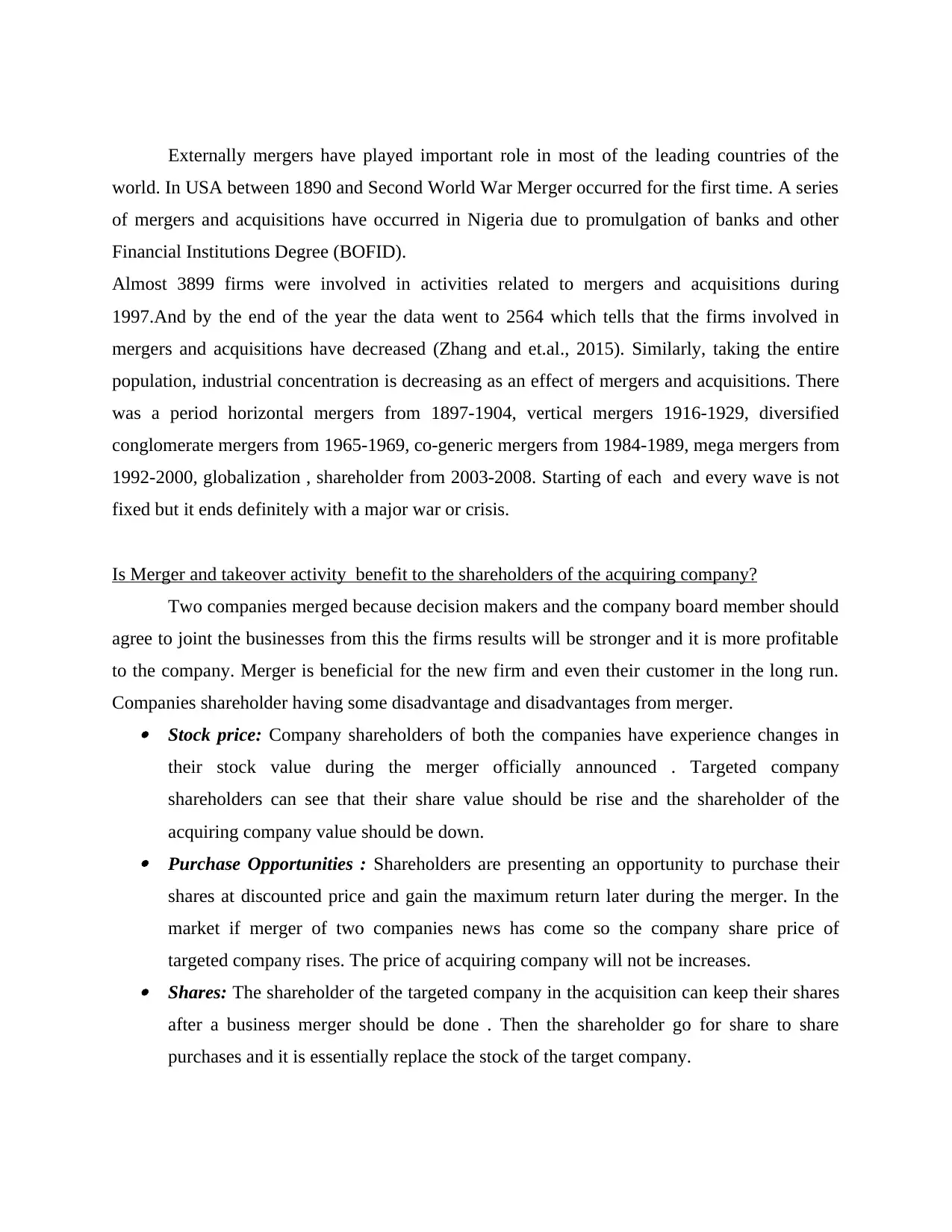
Externally mergers have played important role in most of the leading countries of the
world. In USA between 1890 and Second World War Merger occurred for the first time. A series
of mergers and acquisitions have occurred in Nigeria due to promulgation of banks and other
Financial Institutions Degree (BOFID).
Almost 3899 firms were involved in activities related to mergers and acquisitions during
1997.And by the end of the year the data went to 2564 which tells that the firms involved in
mergers and acquisitions have decreased (Zhang and et.al., 2015). Similarly, taking the entire
population, industrial concentration is decreasing as an effect of mergers and acquisitions. There
was a period horizontal mergers from 1897-1904, vertical mergers 1916-1929, diversified
conglomerate mergers from 1965-1969, co-generic mergers from 1984-1989, mega mergers from
1992-2000, globalization , shareholder from 2003-2008. Starting of each and every wave is not
fixed but it ends definitely with a major war or crisis.
Is Merger and takeover activity benefit to the shareholders of the acquiring company?
Two companies merged because decision makers and the company board member should
agree to joint the businesses from this the firms results will be stronger and it is more profitable
to the company. Merger is beneficial for the new firm and even their customer in the long run.
Companies shareholder having some disadvantage and disadvantages from merger. Stock price: Company shareholders of both the companies have experience changes in
their stock value during the merger officially announced . Targeted company
shareholders can see that their share value should be rise and the shareholder of the
acquiring company value should be down. Purchase Opportunities : Shareholders are presenting an opportunity to purchase their
shares at discounted price and gain the maximum return later during the merger. In the
market if merger of two companies news has come so the company share price of
targeted company rises. The price of acquiring company will not be increases. Shares: The shareholder of the targeted company in the acquisition can keep their shares
after a business merger should be done . Then the shareholder go for share to share
purchases and it is essentially replace the stock of the target company.
world. In USA between 1890 and Second World War Merger occurred for the first time. A series
of mergers and acquisitions have occurred in Nigeria due to promulgation of banks and other
Financial Institutions Degree (BOFID).
Almost 3899 firms were involved in activities related to mergers and acquisitions during
1997.And by the end of the year the data went to 2564 which tells that the firms involved in
mergers and acquisitions have decreased (Zhang and et.al., 2015). Similarly, taking the entire
population, industrial concentration is decreasing as an effect of mergers and acquisitions. There
was a period horizontal mergers from 1897-1904, vertical mergers 1916-1929, diversified
conglomerate mergers from 1965-1969, co-generic mergers from 1984-1989, mega mergers from
1992-2000, globalization , shareholder from 2003-2008. Starting of each and every wave is not
fixed but it ends definitely with a major war or crisis.
Is Merger and takeover activity benefit to the shareholders of the acquiring company?
Two companies merged because decision makers and the company board member should
agree to joint the businesses from this the firms results will be stronger and it is more profitable
to the company. Merger is beneficial for the new firm and even their customer in the long run.
Companies shareholder having some disadvantage and disadvantages from merger. Stock price: Company shareholders of both the companies have experience changes in
their stock value during the merger officially announced . Targeted company
shareholders can see that their share value should be rise and the shareholder of the
acquiring company value should be down. Purchase Opportunities : Shareholders are presenting an opportunity to purchase their
shares at discounted price and gain the maximum return later during the merger. In the
market if merger of two companies news has come so the company share price of
targeted company rises. The price of acquiring company will not be increases. Shares: The shareholder of the targeted company in the acquisition can keep their shares
after a business merger should be done . Then the shareholder go for share to share
purchases and it is essentially replace the stock of the target company.
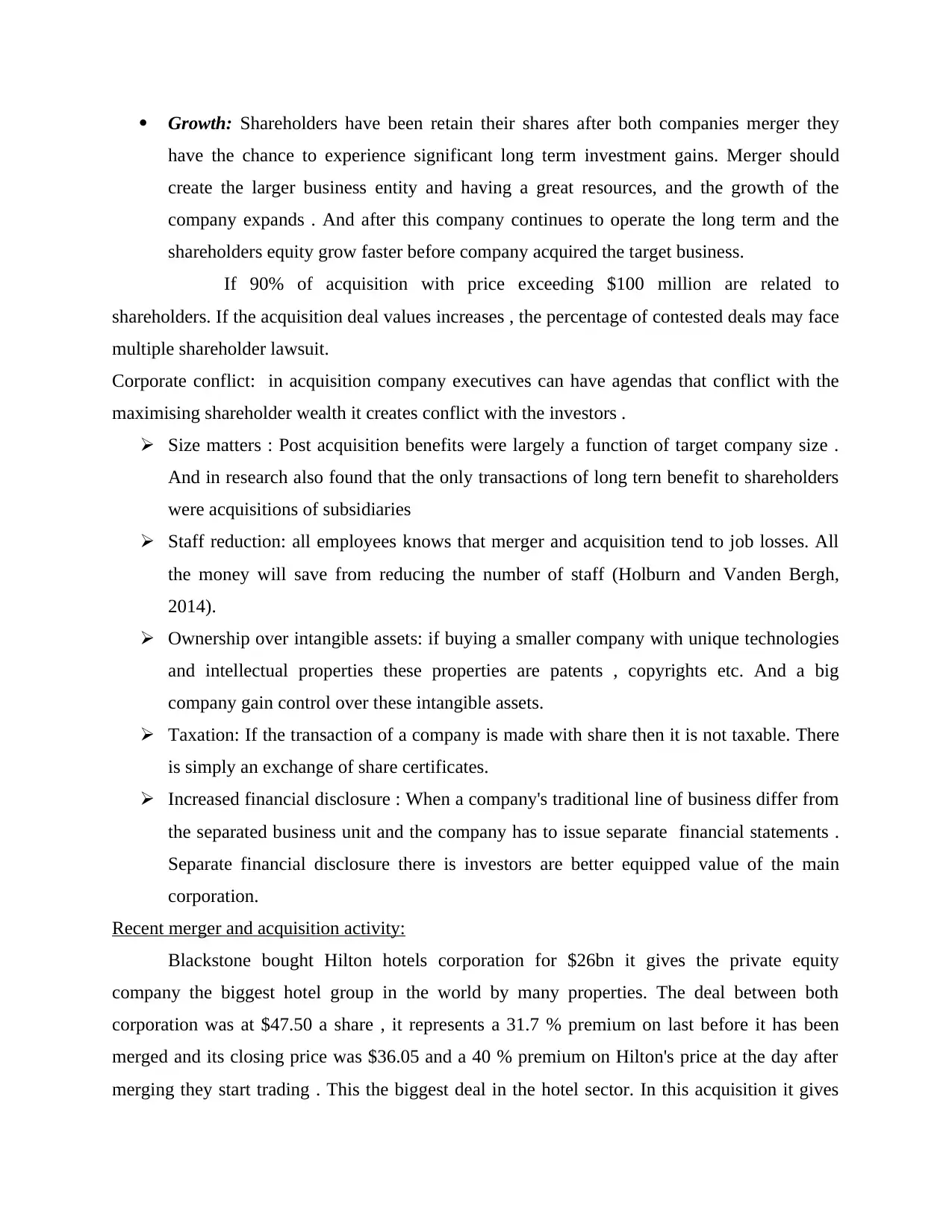
Growth: Shareholders have been retain their shares after both companies merger they
have the chance to experience significant long term investment gains. Merger should
create the larger business entity and having a great resources, and the growth of the
company expands . And after this company continues to operate the long term and the
shareholders equity grow faster before company acquired the target business.
If 90% of acquisition with price exceeding $100 million are related to
shareholders. If the acquisition deal values increases , the percentage of contested deals may face
multiple shareholder lawsuit.
Corporate conflict: in acquisition company executives can have agendas that conflict with the
maximising shareholder wealth it creates conflict with the investors .
Size matters : Post acquisition benefits were largely a function of target company size .
And in research also found that the only transactions of long tern benefit to shareholders
were acquisitions of subsidiaries
Staff reduction: all employees knows that merger and acquisition tend to job losses. All
the money will save from reducing the number of staff (Holburn and Vanden Bergh,
2014).
Ownership over intangible assets: if buying a smaller company with unique technologies
and intellectual properties these properties are patents , copyrights etc. And a big
company gain control over these intangible assets.
Taxation: If the transaction of a company is made with share then it is not taxable. There
is simply an exchange of share certificates.
Increased financial disclosure : When a company's traditional line of business differ from
the separated business unit and the company has to issue separate financial statements .
Separate financial disclosure there is investors are better equipped value of the main
corporation.
Recent merger and acquisition activity:
Blackstone bought Hilton hotels corporation for $26bn it gives the private equity
company the biggest hotel group in the world by many properties. The deal between both
corporation was at $47.50 a share , it represents a 31.7 % premium on last before it has been
merged and its closing price was $36.05 and a 40 % premium on Hilton's price at the day after
merging they start trading . This the biggest deal in the hotel sector. In this acquisition it gives
have the chance to experience significant long term investment gains. Merger should
create the larger business entity and having a great resources, and the growth of the
company expands . And after this company continues to operate the long term and the
shareholders equity grow faster before company acquired the target business.
If 90% of acquisition with price exceeding $100 million are related to
shareholders. If the acquisition deal values increases , the percentage of contested deals may face
multiple shareholder lawsuit.
Corporate conflict: in acquisition company executives can have agendas that conflict with the
maximising shareholder wealth it creates conflict with the investors .
Size matters : Post acquisition benefits were largely a function of target company size .
And in research also found that the only transactions of long tern benefit to shareholders
were acquisitions of subsidiaries
Staff reduction: all employees knows that merger and acquisition tend to job losses. All
the money will save from reducing the number of staff (Holburn and Vanden Bergh,
2014).
Ownership over intangible assets: if buying a smaller company with unique technologies
and intellectual properties these properties are patents , copyrights etc. And a big
company gain control over these intangible assets.
Taxation: If the transaction of a company is made with share then it is not taxable. There
is simply an exchange of share certificates.
Increased financial disclosure : When a company's traditional line of business differ from
the separated business unit and the company has to issue separate financial statements .
Separate financial disclosure there is investors are better equipped value of the main
corporation.
Recent merger and acquisition activity:
Blackstone bought Hilton hotels corporation for $26bn it gives the private equity
company the biggest hotel group in the world by many properties. The deal between both
corporation was at $47.50 a share , it represents a 31.7 % premium on last before it has been
merged and its closing price was $36.05 and a 40 % premium on Hilton's price at the day after
merging they start trading . This the biggest deal in the hotel sector. In this acquisition it gives
⊘ This is a preview!⊘
Do you want full access?
Subscribe today to unlock all pages.

Trusted by 1+ million students worldwide
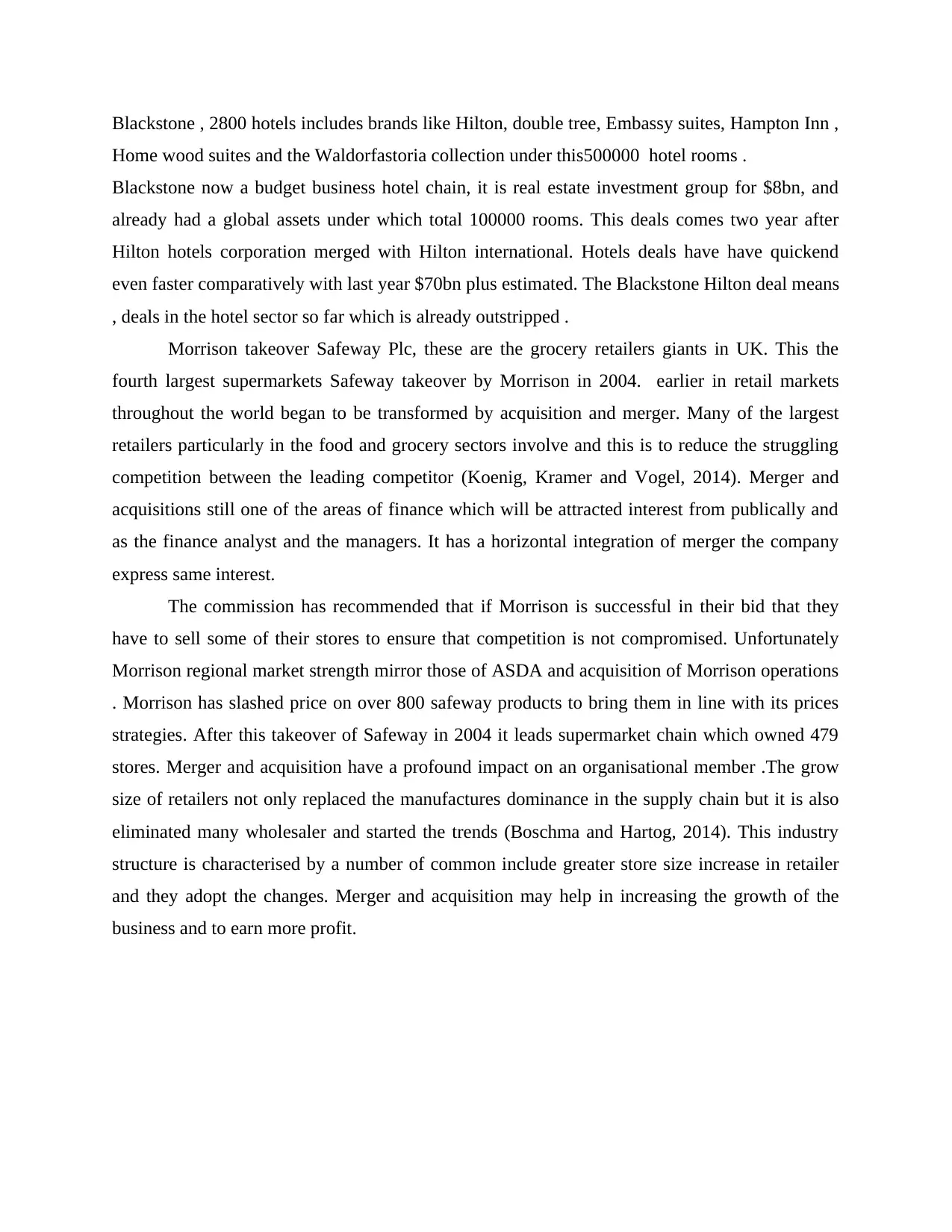
Blackstone , 2800 hotels includes brands like Hilton, double tree, Embassy suites, Hampton Inn ,
Home wood suites and the Waldorfastoria collection under this500000 hotel rooms .
Blackstone now a budget business hotel chain, it is real estate investment group for $8bn, and
already had a global assets under which total 100000 rooms. This deals comes two year after
Hilton hotels corporation merged with Hilton international. Hotels deals have have quickend
even faster comparatively with last year $70bn plus estimated. The Blackstone Hilton deal means
, deals in the hotel sector so far which is already outstripped .
Morrison takeover Safeway Plc, these are the grocery retailers giants in UK. This the
fourth largest supermarkets Safeway takeover by Morrison in 2004. earlier in retail markets
throughout the world began to be transformed by acquisition and merger. Many of the largest
retailers particularly in the food and grocery sectors involve and this is to reduce the struggling
competition between the leading competitor (Koenig, Kramer and Vogel, 2014). Merger and
acquisitions still one of the areas of finance which will be attracted interest from publically and
as the finance analyst and the managers. It has a horizontal integration of merger the company
express same interest.
The commission has recommended that if Morrison is successful in their bid that they
have to sell some of their stores to ensure that competition is not compromised. Unfortunately
Morrison regional market strength mirror those of ASDA and acquisition of Morrison operations
. Morrison has slashed price on over 800 safeway products to bring them in line with its prices
strategies. After this takeover of Safeway in 2004 it leads supermarket chain which owned 479
stores. Merger and acquisition have a profound impact on an organisational member .The grow
size of retailers not only replaced the manufactures dominance in the supply chain but it is also
eliminated many wholesaler and started the trends (Boschma and Hartog, 2014). This industry
structure is characterised by a number of common include greater store size increase in retailer
and they adopt the changes. Merger and acquisition may help in increasing the growth of the
business and to earn more profit.
Home wood suites and the Waldorfastoria collection under this500000 hotel rooms .
Blackstone now a budget business hotel chain, it is real estate investment group for $8bn, and
already had a global assets under which total 100000 rooms. This deals comes two year after
Hilton hotels corporation merged with Hilton international. Hotels deals have have quickend
even faster comparatively with last year $70bn plus estimated. The Blackstone Hilton deal means
, deals in the hotel sector so far which is already outstripped .
Morrison takeover Safeway Plc, these are the grocery retailers giants in UK. This the
fourth largest supermarkets Safeway takeover by Morrison in 2004. earlier in retail markets
throughout the world began to be transformed by acquisition and merger. Many of the largest
retailers particularly in the food and grocery sectors involve and this is to reduce the struggling
competition between the leading competitor (Koenig, Kramer and Vogel, 2014). Merger and
acquisitions still one of the areas of finance which will be attracted interest from publically and
as the finance analyst and the managers. It has a horizontal integration of merger the company
express same interest.
The commission has recommended that if Morrison is successful in their bid that they
have to sell some of their stores to ensure that competition is not compromised. Unfortunately
Morrison regional market strength mirror those of ASDA and acquisition of Morrison operations
. Morrison has slashed price on over 800 safeway products to bring them in line with its prices
strategies. After this takeover of Safeway in 2004 it leads supermarket chain which owned 479
stores. Merger and acquisition have a profound impact on an organisational member .The grow
size of retailers not only replaced the manufactures dominance in the supply chain but it is also
eliminated many wholesaler and started the trends (Boschma and Hartog, 2014). This industry
structure is characterised by a number of common include greater store size increase in retailer
and they adopt the changes. Merger and acquisition may help in increasing the growth of the
business and to earn more profit.
Paraphrase This Document
Need a fresh take? Get an instant paraphrase of this document with our AI Paraphraser
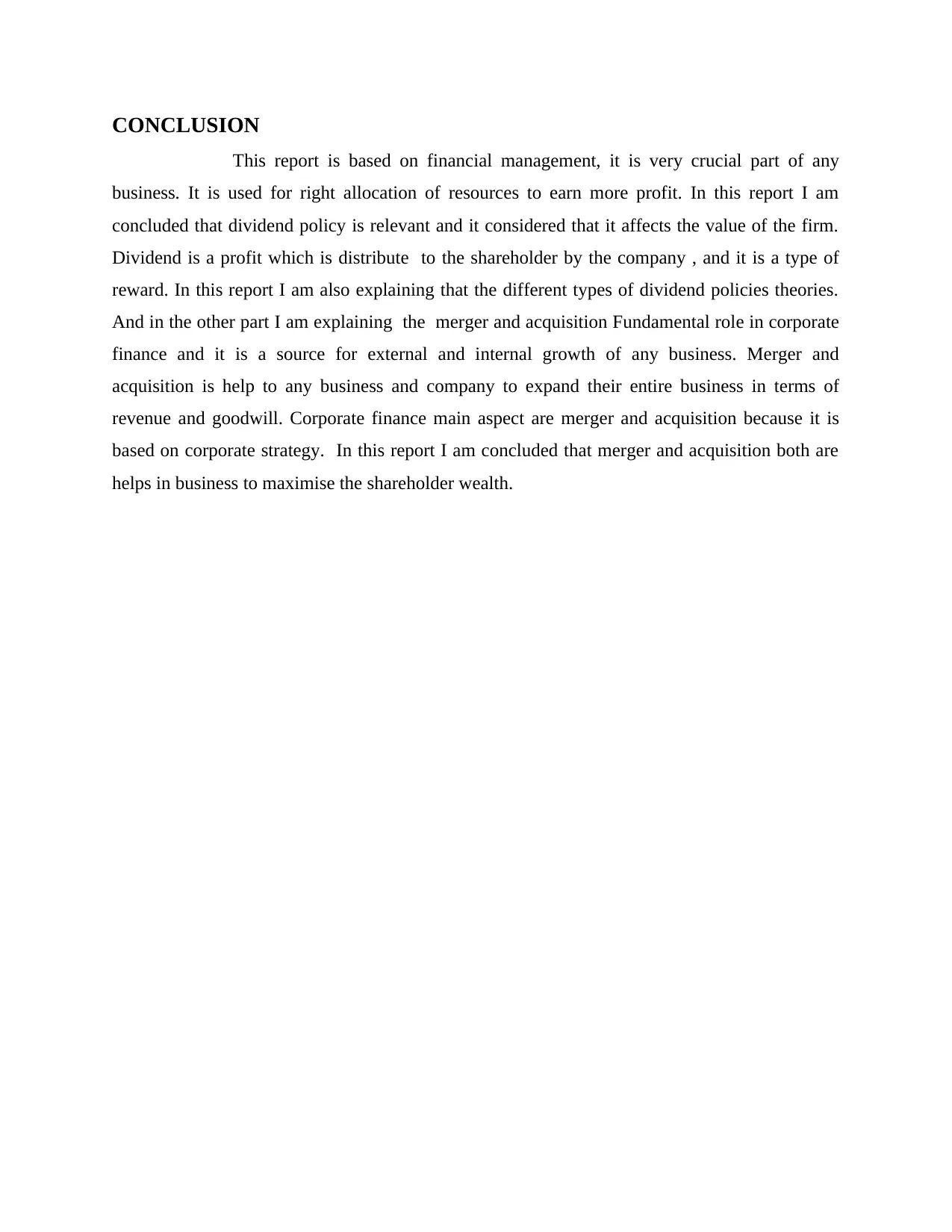
CONCLUSION
This report is based on financial management, it is very crucial part of any
business. It is used for right allocation of resources to earn more profit. In this report I am
concluded that dividend policy is relevant and it considered that it affects the value of the firm.
Dividend is a profit which is distribute to the shareholder by the company , and it is a type of
reward. In this report I am also explaining that the different types of dividend policies theories.
And in the other part I am explaining the merger and acquisition Fundamental role in corporate
finance and it is a source for external and internal growth of any business. Merger and
acquisition is help to any business and company to expand their entire business in terms of
revenue and goodwill. Corporate finance main aspect are merger and acquisition because it is
based on corporate strategy. In this report I am concluded that merger and acquisition both are
helps in business to maximise the shareholder wealth.
This report is based on financial management, it is very crucial part of any
business. It is used for right allocation of resources to earn more profit. In this report I am
concluded that dividend policy is relevant and it considered that it affects the value of the firm.
Dividend is a profit which is distribute to the shareholder by the company , and it is a type of
reward. In this report I am also explaining that the different types of dividend policies theories.
And in the other part I am explaining the merger and acquisition Fundamental role in corporate
finance and it is a source for external and internal growth of any business. Merger and
acquisition is help to any business and company to expand their entire business in terms of
revenue and goodwill. Corporate finance main aspect are merger and acquisition because it is
based on corporate strategy. In this report I am concluded that merger and acquisition both are
helps in business to maximise the shareholder wealth.
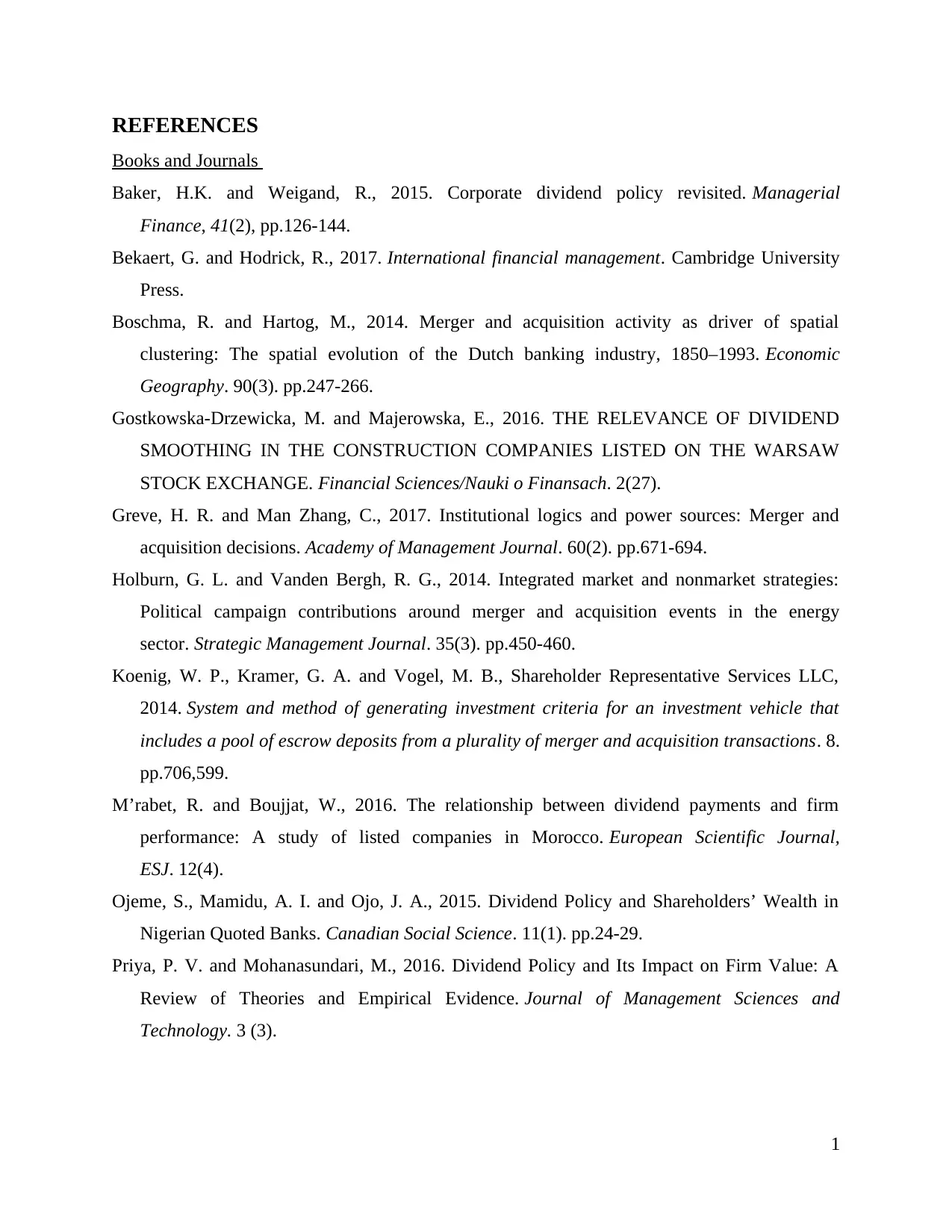
REFERENCES
Books and Journals
Baker, H.K. and Weigand, R., 2015. Corporate dividend policy revisited. Managerial
Finance, 41(2), pp.126-144.
Bekaert, G. and Hodrick, R., 2017. International financial management. Cambridge University
Press.
Boschma, R. and Hartog, M., 2014. Merger and acquisition activity as driver of spatial
clustering: The spatial evolution of the Dutch banking industry, 1850–1993. Economic
Geography. 90(3). pp.247-266.
Gostkowska-Drzewicka, M. and Majerowska, E., 2016. THE RELEVANCE OF DIVIDEND
SMOOTHING IN THE CONSTRUCTION COMPANIES LISTED ON THE WARSAW
STOCK EXCHANGE. Financial Sciences/Nauki o Finansach. 2(27).
Greve, H. R. and Man Zhang, C., 2017. Institutional logics and power sources: Merger and
acquisition decisions. Academy of Management Journal. 60(2). pp.671-694.
Holburn, G. L. and Vanden Bergh, R. G., 2014. Integrated market and nonmarket strategies:
Political campaign contributions around merger and acquisition events in the energy
sector. Strategic Management Journal. 35(3). pp.450-460.
Koenig, W. P., Kramer, G. A. and Vogel, M. B., Shareholder Representative Services LLC,
2014. System and method of generating investment criteria for an investment vehicle that
includes a pool of escrow deposits from a plurality of merger and acquisition transactions. 8.
pp.706,599.
M’rabet, R. and Boujjat, W., 2016. The relationship between dividend payments and firm
performance: A study of listed companies in Morocco. European Scientific Journal,
ESJ. 12(4).
Ojeme, S., Mamidu, A. I. and Ojo, J. A., 2015. Dividend Policy and Shareholders’ Wealth in
Nigerian Quoted Banks. Canadian Social Science. 11(1). pp.24-29.
Priya, P. V. and Mohanasundari, M., 2016. Dividend Policy and Its Impact on Firm Value: A
Review of Theories and Empirical Evidence. Journal of Management Sciences and
Technology. 3 (3).
1
Books and Journals
Baker, H.K. and Weigand, R., 2015. Corporate dividend policy revisited. Managerial
Finance, 41(2), pp.126-144.
Bekaert, G. and Hodrick, R., 2017. International financial management. Cambridge University
Press.
Boschma, R. and Hartog, M., 2014. Merger and acquisition activity as driver of spatial
clustering: The spatial evolution of the Dutch banking industry, 1850–1993. Economic
Geography. 90(3). pp.247-266.
Gostkowska-Drzewicka, M. and Majerowska, E., 2016. THE RELEVANCE OF DIVIDEND
SMOOTHING IN THE CONSTRUCTION COMPANIES LISTED ON THE WARSAW
STOCK EXCHANGE. Financial Sciences/Nauki o Finansach. 2(27).
Greve, H. R. and Man Zhang, C., 2017. Institutional logics and power sources: Merger and
acquisition decisions. Academy of Management Journal. 60(2). pp.671-694.
Holburn, G. L. and Vanden Bergh, R. G., 2014. Integrated market and nonmarket strategies:
Political campaign contributions around merger and acquisition events in the energy
sector. Strategic Management Journal. 35(3). pp.450-460.
Koenig, W. P., Kramer, G. A. and Vogel, M. B., Shareholder Representative Services LLC,
2014. System and method of generating investment criteria for an investment vehicle that
includes a pool of escrow deposits from a plurality of merger and acquisition transactions. 8.
pp.706,599.
M’rabet, R. and Boujjat, W., 2016. The relationship between dividend payments and firm
performance: A study of listed companies in Morocco. European Scientific Journal,
ESJ. 12(4).
Ojeme, S., Mamidu, A. I. and Ojo, J. A., 2015. Dividend Policy and Shareholders’ Wealth in
Nigerian Quoted Banks. Canadian Social Science. 11(1). pp.24-29.
Priya, P. V. and Mohanasundari, M., 2016. Dividend Policy and Its Impact on Firm Value: A
Review of Theories and Empirical Evidence. Journal of Management Sciences and
Technology. 3 (3).
1
⊘ This is a preview!⊘
Do you want full access?
Subscribe today to unlock all pages.

Trusted by 1+ million students worldwide
1 out of 13
Related Documents
Your All-in-One AI-Powered Toolkit for Academic Success.
+13062052269
info@desklib.com
Available 24*7 on WhatsApp / Email
![[object Object]](/_next/static/media/star-bottom.7253800d.svg)
Unlock your academic potential
Copyright © 2020–2025 A2Z Services. All Rights Reserved. Developed and managed by ZUCOL.





